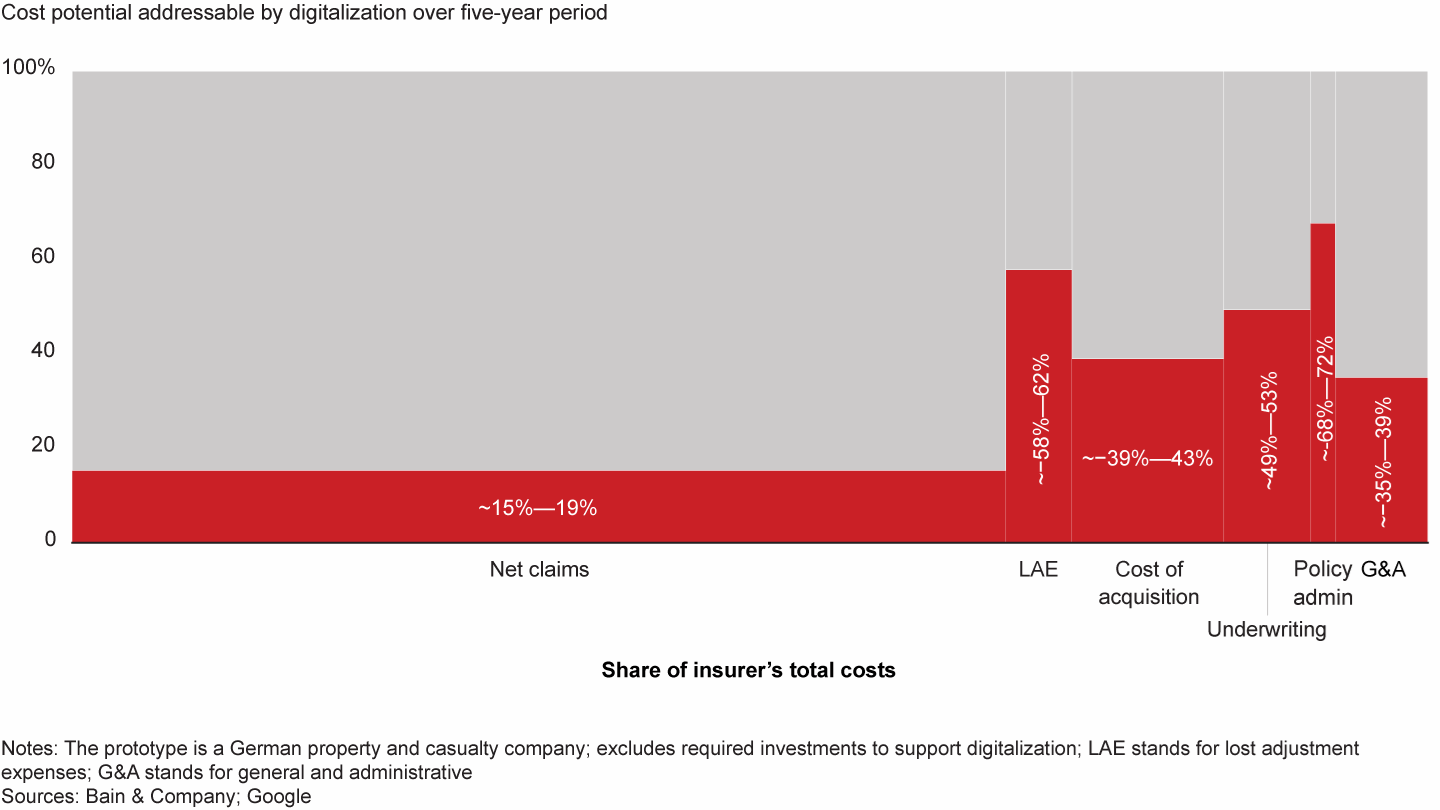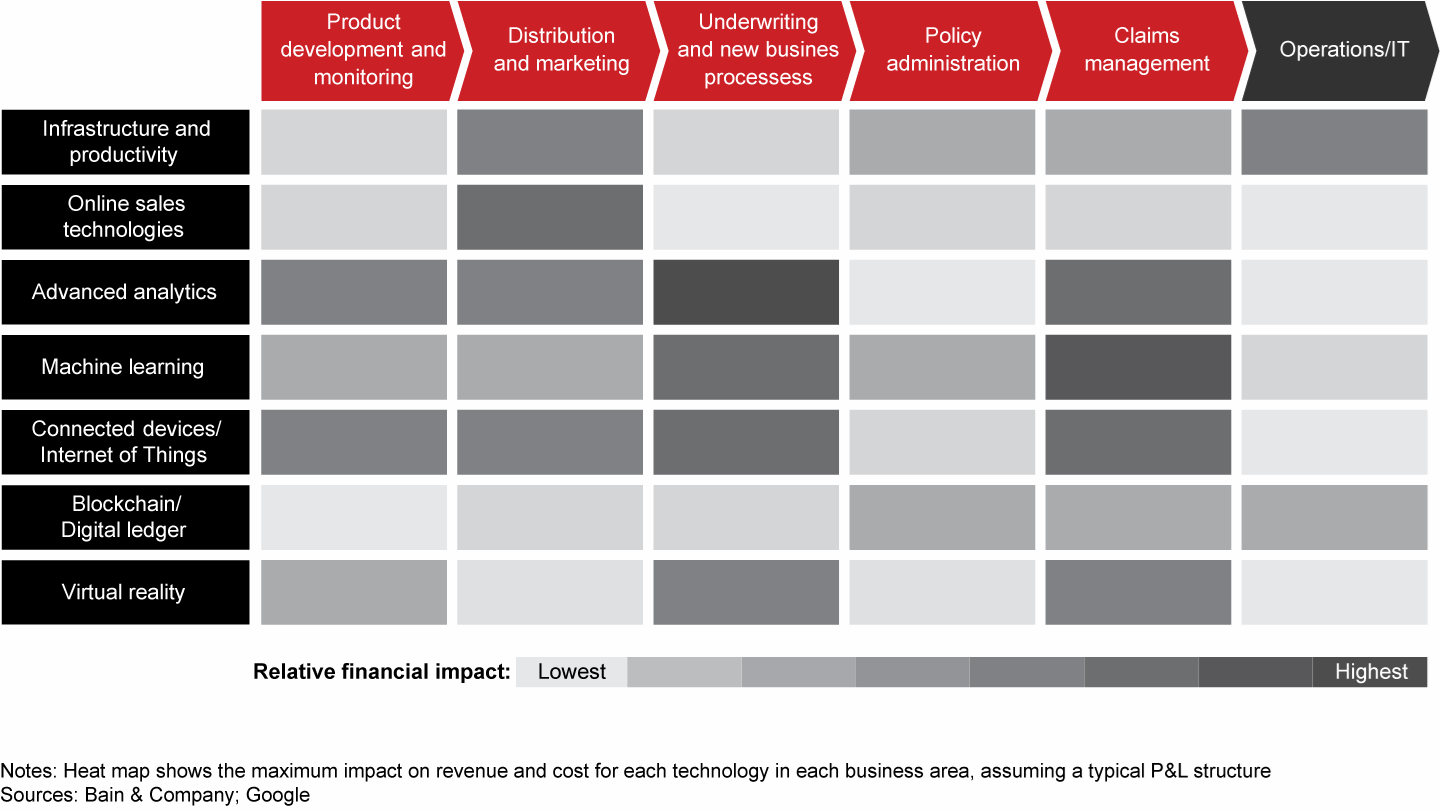論説

The business of property and casualty insurance—assessing risk, collecting premiums and paying claims—hasn’t changed much since 1861, when a group of underwriters sold the first policies to protect London homeowners against losses from fire. Recently, though, the insurance industry has embarked on a radical transformation, one spurred by a series of digital innovations whose widespread adoption is just a few years away. Bain & Company and Google have identified seven key technologies—namely, infrastructure and productivity, online sales technologies, advanced analytics, machine learning, the Internet of Things, distributed ledger and virtual reality—that have already begun to disrupt the industry and whose impact will accelerate in the next three to five years. These new technologies are likely to be a boon for consumers, bringing more choice, better service and lower prices.
Written in collaboration with
Written in collaboration with

For those insurers ready to seize the initiative, digitalization presents an immense opportunity. The companies that stand to benefit the most are those that use the impetus of digitalization to rethink all their operations, from underwriting to customer service to claims management. The impact on both revenues and costs can be enormous. An analysis by Bain and Google shows that a prototypical P&C insurer in Germany that implemented these technologies could increase its revenues by up to 28% within five years, reduce claims payouts by as much 19% and cut policy administration costs by as much as 72% (see Figure 1).
These pioneers in digital technology can gain an edge over their rivals by becoming more effective and efficient. They’ll be able to trim costs and pass on those savings to their customers, thereby winning new business and gaining market share. The digital laggards, by contrast, will find themselves fighting an intensified price war and scrambling to protect their competitive positions.
Customers are pressing for change. They now expect their insurers to offer simple, transparent and flexible products and services—all online. And companies have begun to respond. In Australia, for example, you can use your smartphone to snap a photo of something you want to insure, such as a bicycle; upload the picture into an app called Trov; and then request a policy for a specific period, say a month. Trov uses available data about you and your bicycle and, within seconds, comes back with an offer. If you like the terms, you press the “I accept” button, and you’re covered. Claims are also handled online, with a rapid exchange of photos and texts.
So far, companies have focused primarily on customer-facing applications. But some insurers are beginning to realize that digital means much more than cool and convenient apps for consumers; it is a force that will touch and reshape the very core of their business. Yet firms will reap the full benefit of digital technology only when they embrace its potential along the entire insurance value chain, including underwriting and claims management.
Potential savings from digitalization at prototypical German P&C insurer


Seven disruptive technologies
To assess the impact of various technologies along the insurance value chain, Bain and Google identified and analyzed more than 100 digital use cases and focused on the 30 most likely to be disruptive within the next three to five years. Technologies that fall outside of that time frame, even potentially transformative ones like self-driving cars, biosensors and smart contact lenses, were excluded. The 30 use cases were grouped into seven broad categories and evaluated for the effect they would have on the revenues and profits of a prototypical German insurer—and by extension on the global insurance industry (see Figure 2):
- Infrastructure and productivity. A modern IT architecture is critical for digital innovation. Many insurers consider the cloud the best option for processing, computation and storage. They can also use productivity tools such as coauthoring and video calling, and they can connect with their customers through a seamless, omnichannel approach.
- Online sales technologies. Insurers can use cutting-edge techniques for targeting customers, identifying user groups and analyzing consumption patterns.
- Advanced analytics (AA). With AA, insurers can gain extensive insights into customer needs and preferences. Insurers can also draw on it to help fight fraud.
- Machine learning. With machine learning, insurers’ information systems can quickly adapt to new data, without the need for reprogramming. Insurers can use machine learning to shape underwriting, price products and manage claims.
- The Internet of Things. Networked devices in cars and buildings can protect people and property and facilitate proactive, preventive maintenance, thus reducing accidents—and claims. By analyzing data from sensors embedded in vehicles and other equipment, insurers can gain insights into customer behavior.
- Distributed ledger technology. By arranging and documenting claims on distributed ledgers, insurers can greatly reduce processing time. A whole new field is opening up for smart contracts—that is, policies that are fully automated and updated based on a blockchain’s entire database.
- Virtual reality (VR). The global fascination with the smartphone game Pokémon Go shows VR’s popularity, but this technology also has the potential to transform the way information for underwriting is gathered, as well as the way claims are settled. For example, an insurer could use VR to create a three-dimensional image of a room or to reconstruct an accident in minute detail.
Impact of seven technologies on a prototypical German insurer over five years


The common feature all these technologies share is their practical relevance. They are already in use today in differing degrees and will be widely available in three to five years. And more change is coming. Entirely new concepts in automotive insurance will be needed for driverless vehicles. Who is at fault in an accident if nobody was driving? 3-D printers will unlock new possibilities for claims settlement. Imagine an insurer “printing” a new fender to replace the one bent in an accident. Even in the near future, though, insurance will look very different.
Key question to ask: Is it good for the customer?
Consider a car accident that occurs three years from now. New technologies will help the involved parties receive help quickly and efficiently. Immediately following an incident, software built into the vehicles can assess the damage and notify a towing service, if necessary. Assuming the drivers are not seriously injured, they can use their smartphones to record 3-D images of the damage and then send the images, together with the electronic address cards of all the involved parties, to their insurance companies.
In the future, insurers won’t need to dispatch human adjusters to gather facts and evaluate accident damage.
Using machine learning, automated advisers will draw on virtual reconstructions of the accident and a wealth of background data. They’ll enter into a virtual dialogue with customers and immediately inform them where any damage can best be repaired.
Insurers deciding which digital technologies to pursue can ask themselves a simple, and fundamental, question: Will it enhance the customer’s experience? Putting the customer first is more than a platitude. Simply put, an improved customer journey—one built on ultraprecise information, greater transparency, more flexibility and simplified interactions—is good for business. Each of the 30 cases that formed the basis of this study will enhance the customer experience—and, at the same time, help companies increase revenues and contain costs.
Take the typical experience of a customer calling an insurer today. It’s likely an automated answering service will say to press buttons 1, 2 or 3 for various options. With machine learning, though, insurers will be able to serve a customer much faster and effectively, without all the button-pushing. The system will instantly analyze the customer’s flow of communications across all channels, including past phone calls, letters, emails and even public social media postings. When the customer starts speaking, the computer can analyze the tone of voice, determining whether the caller is confused or angry or both. Armed with all this information, a virtual agent can assess the customer’s needs and suggest a solution. By the time a real-life agent comes onto the phone—if that’s even necessary—the customer’s problem will likely have been resolved.
Generally speaking, the moment of truth for every customer and every insurer comes when claims need to be processed. Digital technologies will be able to dramatically shorten the period between reporting and settling claims. That’s primarily because all relevant data will be collected within minutes and all parties involved will have access to the same information.
Digital technologies will open up new vistas in claims prevention, thanks to the Internet of Things. In the future, for example, a sensor will be able to monitor a household’s water consumption patterns, detecting potential leaks and interrupting the flow before the basement is flooded, thus preventing major damage and a costly claim.
Henrik Naujoks, who leads Bain's Financial Service practice in Europe, the Middle East and Africa, shares four things insurance companies can do to seize this immense opportunity.
The digital path to higher revenues and lower costs
Digitalization will create fascinating new possibilities for insurers. But what actual implications will these have for revenues and earnings in the next five years? To answer that question, Bain and Google looked at a prototypical German P&C insurer that had adopted all 30 of the most promising digital use cases. Similar prototypes can be derived for specific business lines and for insurers operating in other countries, factoring in regional preferences.
Across markets, insurers that serve individual consumers, as opposed to business customers, are likely to experience the earliest and biggest bottom-line impact from digitalization. Underwriting risk and processing claims for business customers are relatively complex operations, making automation more challenging. But commercial insurers will still be able to benefit from innovation—including the use of 3-D technology to register objects and machine-generated data to calculate policies. Across the entire P&C sector, digitalization presents billions of dollars in opportunities to boost revenues and cut costs.
To exploit these opportunities, the insurance industry needs a major rethink. Many insurers are focusing their digital efforts on product development and distribution, yet it’s underwriting and claims management that hold the biggest potential for change. It’s in those areas that machine learning, advanced analytics and the Internet of Things can have the biggest impact.
Based on the Bain and Google analysis, the prototypical German insurer that consistently pioneers the use of digitalization can expect its premium receipts to rise by about 28% in five years, with most of the increase coming from gains in market share. By operating more efficiently, the insurer will be able to lower its costs, reduce its prices and thereby attract more customers. At the same time, the company will be able to use some of the money saved from its new technologies to invest in more digital innovation—forming a virtuous cycle.
As rich as the potential is for top-line growth, the opportunities for cost reduction are even greater. By using digital technologies, a prototypical insurer can lower its gross costs by up to 29% in five years, with most of that savings coming from claims management. With digital tools, insurers will be able to more effectively underwrite risk, enhance preventions and minimize fraud. By deploying automated advisers and machine learning, they’ll save money on distribution and administration.
To P&C insurers battling in a fiercely competitive marketplace, digitalization can be a multibillion dollar opportunity. The insurers mostly like to reap these benefits are those who give primacy to improving the customer experience. Digital tools that don’t make the customer’s journey more efficient, economical and satisfying aren’t likely to help the insurer’s top or bottom lines. Insurers can use digital tools to deliver added services, lower premiums and an all-around better experience. Companies that do this well will reduce costs and raise revenues—and they’ll be that much further along on the road to achieving a broad-based, customer-focused digital transformation.
Signposts on the digital journey
Take the customer’s point of view. Digitalization is not an end in itself, nor is it primarily a means of increasing profitability. Rather, it is a way to serve evolving and demanding customers. Design digital use cases that improve the customer’s experience and add value. Profits will follow.
Expand your digital horizons. Insurers should establish a view now on those technologies that are likely to add the most customer value and differentiate them from their competitors. The biggest opportunities for gaining sway lie in underwriting and claims management.
Launch and iterate. Rapidly evolving technologies and customer behavior present a challenge to long-term planning. Insurers should quickly bring new prototypes to market and continue to improve them. Companies should abandon those tools that don’t improve the customer experience, help cut costs or give them an edge over their rivals.
Establish a digital culture. Digitalization means much more than technological change. Insurers should commit to new and improved ways of working and serving the customer, with employees who are trained and motivated to work in a digital environment.

About the partnership between Google and Bain & Company
Google has one of the most extensive cross-industry innovation pipelines worldwide that also has major relevance for the financial sector. Bain & Company is one of the world’s leading management consulting firms in the field of banking and insurance. For this study, the insurance teams of both companies have combined their expertise to gain unique insights into the impact that digitalization will have on the customer experience and the operating business of property and casualty insurers.
Henrik Naujoks is a partner in Bain & Company’s Zurich office and leads the firm’s Financial Services practice in Europe, the Middle East and Africa. Florian Mueller, a partner in Bain’s Munich office, is an expert in the Financial Services practice who specializes in insurance. Nikos Kotalakidis is the industry leader for insurance at Google Germany.
Special thanks go to Marian Mohr, manager in Bain’s Zurich Office, and Aurélie Toubol, a consultant in Bain’s Paris Office, as well as to Jan Müller, industry manager for insurance, and Torsten Scholl, industry manager for financial services, at Google Germany.